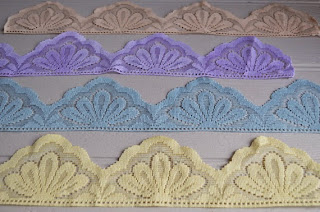Hallelujah, after about 4 hours of annoyance, knocking on neighbours' doors and generally pestering anyone I thought might be able to help me locate the box, my next door neighbour returned from work and had had the parcel all along!
Now to the contents.......
I've had lots more requests for the big cream lace bobbins and was able to acquire the last remaining lot so they will be on their way to new homes soon. The gold coloured ones will have their outer layers of thread removed and soon be on the website refreshed and clean (almost)!
But the box didn't just contain the bobbins, there were 5 wonderful documents also included. Before a jacquard loom can produce a design, whether on cloth or as lace, a series of punched cards has to be made. To do this the original drawing has to be transferred to graph paper. This is known as a point chart with each point or square on the paper corresponding to the
raising or lowering of a weft or warp thread.
The guys clearing out the contents of the Scottish lace mill came across a box of these point charts and I just couldn't resist!
Hard to determine the date of these, but they are probably from the 1930s or thereabouts. One in particular caught my eye - with an elephant depicted in the design.
Most likely this would have been a pattern for a lace intended for curtain panels, the handwritten notes tell us this design is called Klambo Lace. Klambo is a village in Malaysia, obviously the inspiration for this unusual pattern. I'd love to have seen the actual woven piece.
All shapes and sizes of charts as some would have been for narrow lace borders, others for more intricate piece goods.
This is some of the lace edging produced in the factory, probably in the 50 or 60s, so it gives an idea of how the chart drawings were interpreted to be woven into finished products.
Instead of just adding these to my bookshelves as interesting documents, I am planning to have some of them framed. I think the elephant one in particular will look fabulous on the wall.
I am so so glad I finally found my parcel........!









No comments:
Post a Comment